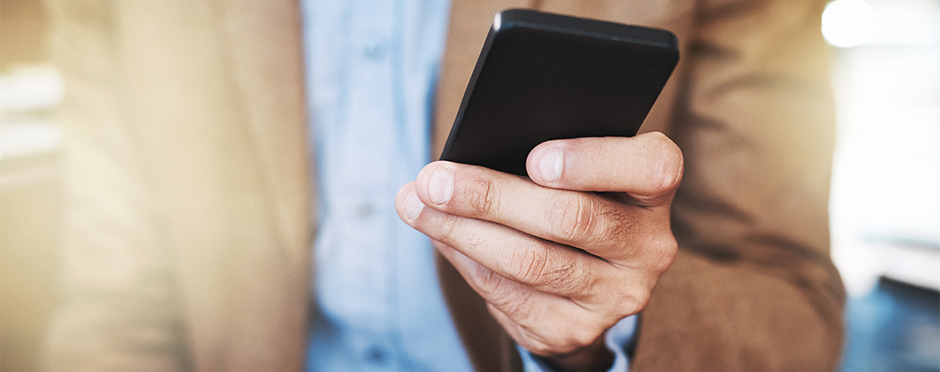
Put Your Phone Down. Your Arms Will Thank You!
Leave a CommentHow many times would you estimate that you check your smartphone every day? Twenty? Thirty? Forty? Fifty times or possibly more?
It is not a secret that Americans love technology, some are even obsessed with it. Aside from using smartphones for the basics like calling and texting, we also use these devices to access directions, look up menus, pay for our Starbucks orders, read the latest Facebook gossip, tweet our favorite brands and google just about everything.
A study recently released by Deloitte found that Americans collectively check their smartphones upward of 8 billion times per day, with the average American checking their phone 46 times per day!2 Since personal electronic devices have made their way into our lives, or should I say hands, many individuals have noticed an increase in joint and tendon problems stemming from increased or constant use of these devices. Fortunately, many of these conditions are highly treatable.
Texting Thumb
Thumb pain or “texting thumb” is not clearly defined; however, depending on which side of the thumb the pain is located determines what the diagnosis may be. Pain on the palm side of the thumb, along with a “painful catching or popping” when the thumb bends and straightens, is a diagnosis called trigger thumb. Trigger thumb often results from repetitive gripping motions such as texting or holding a smartphone. Trigger thumb can often be successfully treated through cortisone injections. In more severe cases, a small surgical procedure may be required to release the pulley at the base of the thumb so the tendon can move more easily.
DeQuervains Tenosynovitis
Pain on the back side of the thumb could be diagnosed as DeQuervains Tenosynovitis. More than likely, if there is pain in this location of the hand/wrist, it will hurt to turn the wrist, grasp anything or make a fist. The exact cause of DeQuervain’s Tenosynovitis isn’t known, but any activity that relies on repetitive hand or wrist movement can make it worse. This is often seen in new mothers given how often and prolonged they are using their hands with a new baby. This form of tenosynovitis can be treated through a more conservative approach involving therapy and splinting, as well as with a more aggressive approach like cortisone injections or a surgical procedure.
Selfie Elbow
“Selfie Elbow” has seen a hike in recognition thanks to a statement made by Today Show host Hoda Kotb that her elbow pain was a result of her love for selfies. Although this might sound ridiculous, try using your smartphone to take a selfie. Awkward right? Depending on which side of the elbow it is affecting, selfie elbow is more commonly known as tennis elbow or golfer’s elbow. These two conditions result from inflammation in the tendons that run from the hand to the elbow. Both tennis elbow and golfer’s elbow can be easily treated through physical or occupational therapy, where patients are instructed in stretching, eccentric strengthening and appropriate body mechanics.
Text Neck
When there is an increase in time spent on tablets and smartphones, significant stress and strain is put on neck and shoulder muscles, also known as “text neck.” This constant state of looking down with the shoulders rolled forward can cause pain throughout the neck and shoulders and could lead to further issues throughout the arm. These symptoms can often be resolved with physical or occupational therapy through a series of stretches, modalities and proper strengthening.
Tablet Tingling
Have you ever been relaxing at home browsing Pinterest or catching up on the latest Facebook gossip and noticed that your hands feel like they have gone to sleep? Nerve compression with use of a tablet or smartphone is something many of us face on a daily basis due to the positions that these devices place us in. “Tablet Tingling” or “iPad Hand” can easily be addressed with conservative management such as splinting, therapy to address nerve compression and education on provocative positions. If these symptoms continue to linger, a referral to a local hand or spine surgeon may be required.
Technology and Overuse Injuries
As technology continues to infiltrate the world we are set to see a continued increase in technology-related overuse injuries. Cellphones, tablets and computers can put us in unnatural positions for extended periods of time, which can lead to more serious problems down the line. Luckily most of these conditions can be treated successfully and quickly if addressed at the early onset of symptoms. If you have aches or pains that you think may be related to the aforementioned conditions, make sure to schedule a free assessment at your nearest Athletico location.
The Athletico blog is an educational resource written by Athletico employees. Athletico bloggers are licensed professionals who abide by the code of ethics outlined by their respective professional associations. The content published in blog posts represents the opinion of the individual author based on their expertise and experience. The content provided in this blog is for informational purposes only, does not constitute medical advice and should not be relied on for making personal health decisions.
References:
1. Amadio, P.C., Fedorczyk, J.M., Osterman, A.L., Skirven, T.M. (Eds.) (2011). Rehabilitation of the Hand and Upper Extremity. Philadelphia, PA: Elsevier
2. Deloitte: 2015 Global Mobile Consumer Survery: US Edition. The Rise of the Always-Connected Consumer.
3. Tsukayama, H. (2016, July 5). ‘Selfie elbow’ is the latest in a long line of tech-related injuries. The Washington Post. Retrieved from www.washingtonpost.com
